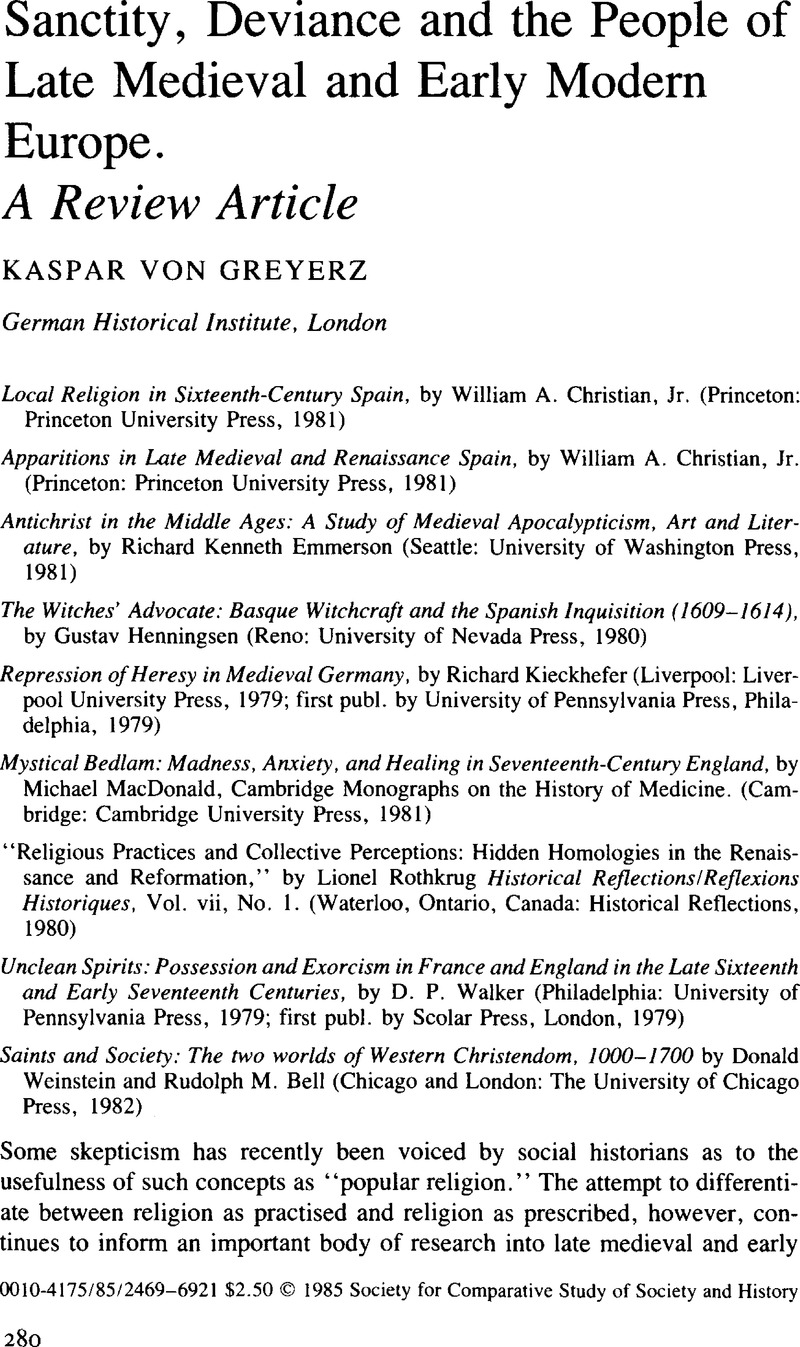No CrossRef data available.
Article contents
Sanctity, Deviance and the People of Late Medieval and Early Modern Europe. A Review Article
Published online by Cambridge University Press: 03 June 2009
Abstract
An abstract is not available for this content so a preview has been provided. Please use the Get access link above for information on how to access this content.

- Type
- Profane Uses of the Sacred
- Information
- Copyright
- Copyright © Society for the Comparative Study of Society and History 1985
References
Burke, Peter. 1982. “A question of acculturation?,” in Scienze, Credenze Occulte, Livelli di Cultura … Florence: Leo S. Olschki, 196–204.Google Scholar
Clark, Stuart. 1983. “French Historians and Early Modern Popular Culture,” Past & Present, (08), 62–99.CrossRefGoogle Scholar
Delumeau, Jean 1979. Le Catholicisme entre Luther et Voltaire. Nouvelle Clio, vol. xxx bis, 2nd edn, Paris: P.U.F.Google Scholar
Göllner, Carl. 1978. Turcica, vol. iii: Die Türkenfrage in der öffentlichen Meinung Europas im 16. Jahrhundert. Bibliotheca Bibliographica Aureliana, vol. lxx. Bucharest and Baden-Baden: Ed. Academici and Körner.Google Scholar
Greyerz, Kaspar von. 1980. The Late City Reformation in Germany: The case of Colmar, 1522–1628. Veröffentlichungen des Instituts fur Europäische Geschichte Mainz, vol. xcviii, Wiesbaden: Steiner.Google Scholar
Greyerz, Kaspar von. ed. 1984. Religion and Society in Early Modern Europe, 1500–1800. London: Allen & Unwin.Google Scholar
Hörger, Hermann. 1984. “Organisational forms of popular piety in rural Old Bavaria sixteenth-nineteenth centuries),” in Greyerz 1984, 212–22.Google Scholar
Kittelson, James. 1982. “Successes and Failures in the German Reformation: The Report from Strasbourg,” Archive for Reformation History, lxxiii, 153–175.CrossRefGoogle Scholar
Midelfort, H. C. Erik. 1972. Witch Hunting in Southwestern Germany, 1562–1684 … Stanford: Stanford University Press.Google Scholar
Moeller, Bernd. 1962. Reichsstadt und Reformation. Gütersloh: Gerd Mohn. (Also available as Imperial Cities and the Reformation, ed. and trans. Midelfort, H. C. E. and Edwards, M. U., Jr., Philadelphia: Fortress Press, 1972.)Google Scholar
Monter, E. William. 1976. Witchcraft in France and Switzerland: The Borderlands during the Reformation. Ithaca, N.Y., and London: Cornell University Press.Google Scholar
Rothkrug, Lionel. 1979. “Popular Religion and Holy Shrines: Their Influence on the Origins of the German Reformation and Their Role in German Cultural Development,” in Obelkevich, James, ed., Religion and the People. Chapel Hill: The University of North Carolina Press, 20–86.Google Scholar
Robisheaux, Thomas. 1981. “Peasants and Pastors: Rural Youth Control and the Reformation in Hohenlohe, 1590–1648, Social History, vi (No. 3), 281–300.CrossRefGoogle Scholar
Schmitt, Jean-Claude. 1978. Mort d'une Hérésie: L'Eglise et les cleres face aux béguines et béghards du Rhin supérieur du XIVe au XVe siècle. Paris: Mouton, 1978.Google Scholar
Scribner, R. W.. 1981. For the Sake of Simple Folk: Popular Propaganda for the German Reformation. Cambridge: Cambridge University Press.Google Scholar
Scribner, R. W.. 1982. “Religion, Society and Culture: Reorientating the Reformation,” History Workshop, xiv (Autumn), 2–22.Google Scholar
Scribner, R. W. 1984. “Cosmic Order and Daily Life: Sacred and Secular in Pre-industrial German Society,” in Greyerz 1984, 17–32.Google Scholar
Strauss, Gerald. 1978. Luther's House of Learning: Indoctrination of the Young in the German Reformation. Baltimore and London: The Johns Hopkins University Press.Google Scholar


